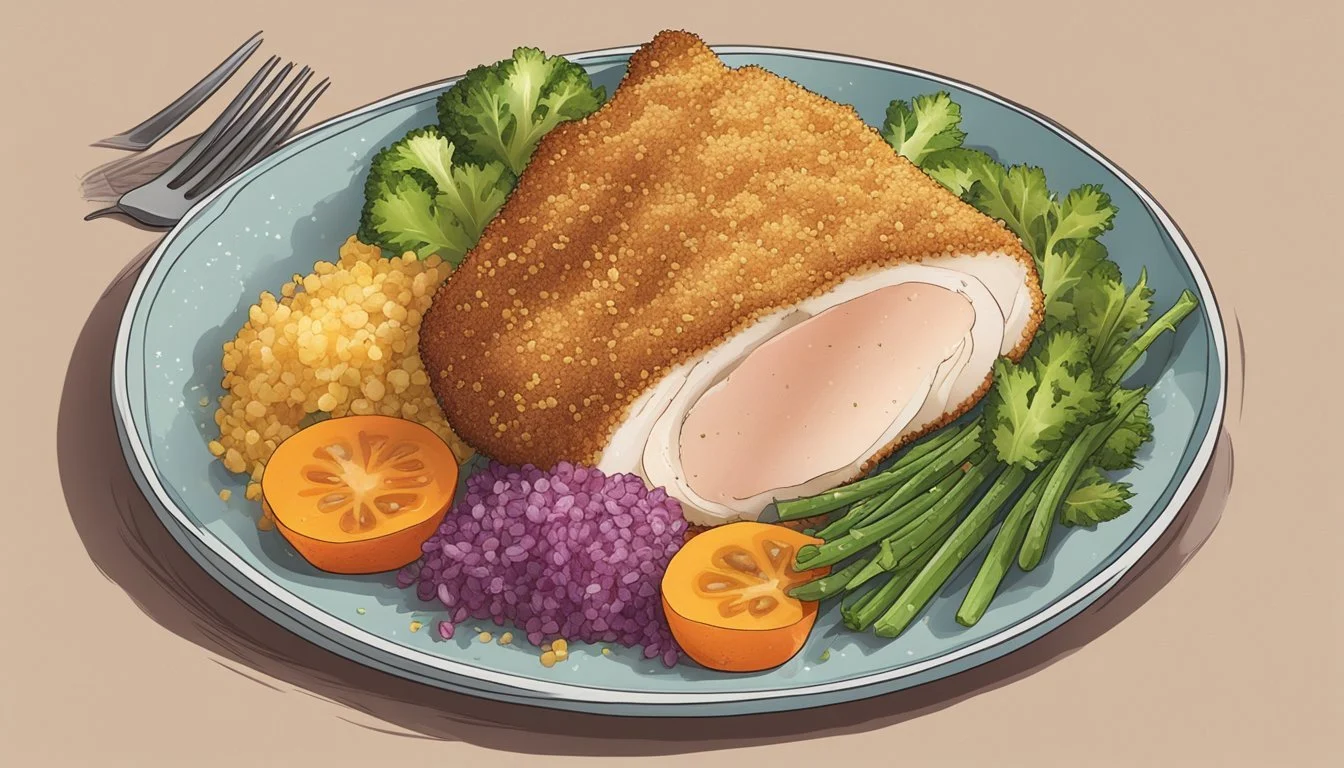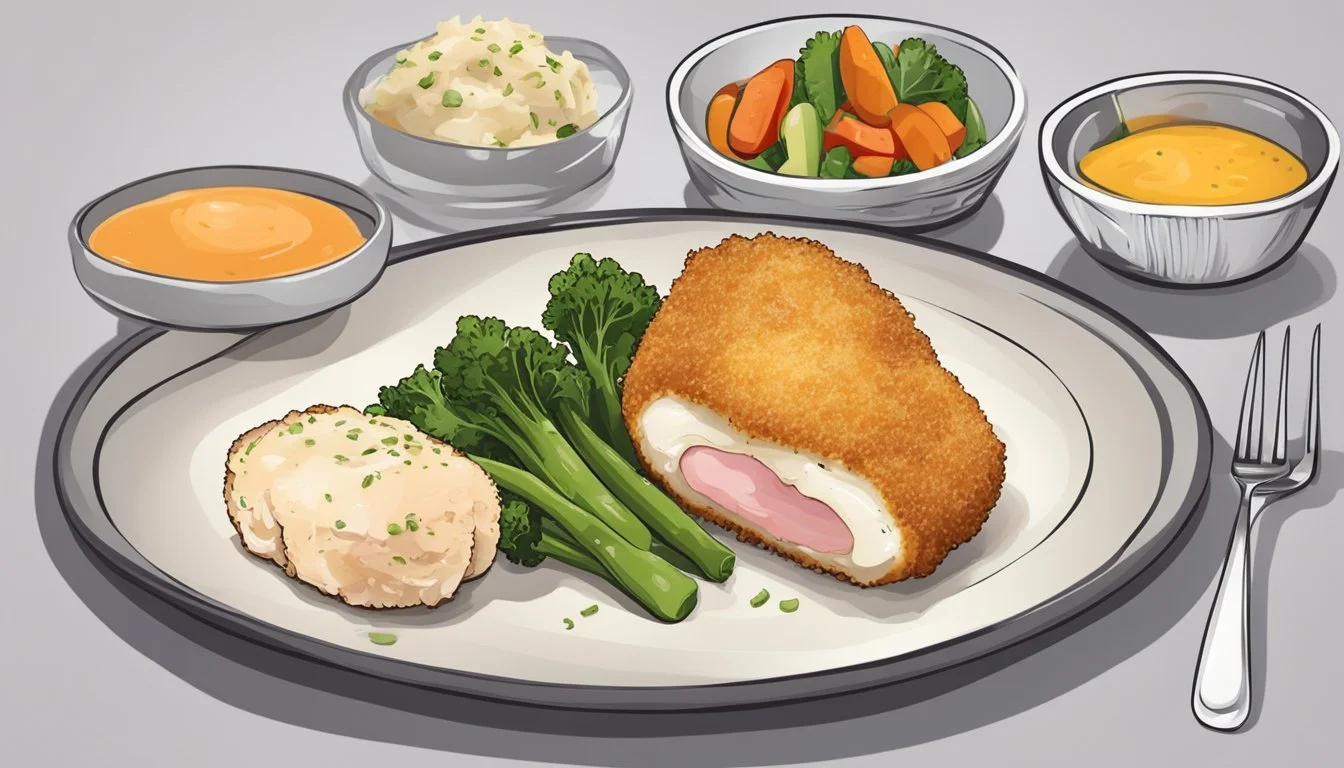Is Chicken Cordon Bleu Gluten-Free?
Unveiling the Truth About This Classic Dish
Chicken Cordon Bleu (What wine goes well with chicken cordon bleu?) typically features a breaded exterior, which traditionally contains gluten. Gluten, a group of proteins found in wheat, barley, and rye, can cause health problems for those with celiac disease or gluten sensitivity. However, this classic dish can indeed be adapted to be gluten-free, allowing those with dietary restrictions to enjoy it.
To prepare a gluten-free version of Chicken Cordon Bleu, chefs substitute the standard bread crumbs and flour for gluten-free alternatives. Gluten-free flour, potato starch, or crushed gluten-free cereals are used to achieve the desired breading, while still maintaining the signature taste and texture. The rest of the dish's components, including the chicken, ham, and cheese, are naturally gluten-free, making them safe for a gluten-free diet when not cross-contaminated with gluten-containing ingredients.
Adaptations of Chicken Cordon Bleu cater to the gluten-free community by offering a way to savor this beloved entrée without compromising dietary needs. With careful ingredient selection and preparation techniques, a gluten-free Chicken Cordon Bleu is both achievable and delectable.
Understanding Gluten-Free Diets
When exploring gluten-free diets, it is vital to understand what gluten is, the benefits of avoiding it for certain individuals, and the practical challenges that come with this dietary change.
What Is Gluten?
Gluten is a protein found chiefly in wheat, barley, and rye, and is responsible for the elastic texture of dough. It acts as a glue that holds food together, which often makes food chewy and can affect the overall texture.
Benefits of a Gluten-Free Diet
For people with celiac disease, consuming gluten triggers an immune response that damages the lining of the small intestine. Adhering to a gluten-free diet can alleviate symptoms and promote intestinal healing. Key benefits include:
Improved digestion: Reduced bloating and gas
Healthier skin: Fewer rashes and episodes of dermatitis herpetiformis, a skin condition linked with celiac
Increased energy: Less fatigue, which is often a symptom of celiac disease
Challenges of Eating Gluten-Free
While a gluten-free diet is essential for managing celiac disease and other gluten-related disorders, it presents several challenges:
Label reading: Diligence is required to identify gluten in food labels, as it can appear in many less obvious food products like sauces and dressings.
Cross-contamination: Restaurants and home kitchens must take care to avoid cross-contact with gluten-containing foods.
Limited options: Pre-packaged gluten-free foods can be more expensive and less available than their gluten-containing counterparts.
By educating oneself about gluten and the associated dietary considerations, those affected by celiac disease or non-celiac gluten sensitivity can better manage their condition.
Components of Chicken Cordon Bleu
Chicken Cordon Bleu is a classic dish that traditionally includes chicken breasts (What wine goes well with chicken breast?), ham, cheese, and a crispy breadcrumb coating. For a gluten-free version, specific substitutions are made in the breading process to accommodate dietary restrictions.
Chicken Breasts
Chicken Cordon Bleu starts with chicken breasts which are the foundation of the dish. They are pounded to thinness to ensure an even cooking time and then typically rolled or folded around the filling.
Ham
Thin slices of ham are used to add a savory flavor contrast to the chicken. The ham is placed on top of the chicken breasts and is important for creating the necessary layers in the dish.
Cheese
Cheese provides the creamy, melting quality that is essential to Chicken Cordon Bleu. Swiss cheese is commonly used, placed atop the ham before the chicken is rolled up. The cheese should melt well and complement both the chicken and ham.
Coating and Breading
The outside of Chicken Cordon Bleu is coated in breadcrumbs which traditionally are made from wheat. To make the dish gluten-free, chefs use gluten-free breadcrumbs or alternatives like gluten-free flour, potato starch, or almond flour. Coating components:
Egg: Often used to help the breadcrumb mixture adhere to the chicken.
Gluten-free breadcrumbs/flour: Ensures that the dish adheres to gluten-free dietary needs while still providing a crisp texture.
Gluten-Free Alternatives for Cordon Bleu
Making Chicken Cordon Bleu gluten-free involves substituting the traditional breading and binding agents with gluten-free alternatives without compromising the dish's classic taste and texture.
Gluten-Free Breading Options
Gluten-Free Bread Crumbs: Gluten-free bread crumbs are readily available in most stores and can effectively replace traditional bread crumbs. They provide a similar texture and can be seasoned to taste.
Gluten-Free Panko: For a lighter, crispier coating, gluten-free panko bread crumbs are an excellent choice. They mimic the texture of traditional panko while being safe for a gluten-free diet.
Almond Flour: A nutritious and low-carb option, almond flour can be used for breading. It offers a nutty flavor and a crunchy exterior when baked or fried.
Table: Gluten-Free Breading Substitutes
Traditional Breading Gluten-Free Alternative Bread Crumbs Gluten-Free Bread Crumbs Panko Gluten-Free Panko Regular Flour Almond Flour/Flour Blend
Gluten-Free Binding Agents
Flour Blend: A gluten-free flour blend typically consists of a mix of rice flour, potato starch, and xanthan gum. This blend can act as a binding agent for the breading process, ensuring that the gluten-free coating adheres to the chicken.
Egg Wash: Beaten eggs serve as an excellent adhesive for the gluten-free breading. Dipping chicken pieces in an egg wash before coating with the chosen gluten-free breading option will help in achieving a uniformly coated surface.
Preparing Gluten-Free Chicken Cordon Bleu
Proper ingredient selection and specific cooking techniques are critical in creating a delicious gluten-free Chicken Cordon Bleu. Using gluten-free alternatives and attention to detail ensures a successful outcome.
Selecting the Right Ingredients
To begin, one must choose gluten-free ingredients for every component of the dish. Traditional Chicken Cordon Bleu recipes are not gluten-free due to flour and breadcrumb components. Here are specific ingredients to consider:
Chicken: Opt for thinly sliced chicken breasts. If unavailable, one can slice them with a knife or use a meat pounder to thin them out.
Gluten-Free Flour: A mix of gluten-free flour or potato starch can replace all-purpose flour in the recipe.
Breading: Create your gluten-free breading with a combination of almond flour, gluten-free bread crumbs, or certified gluten-free panko.
Cheese and Ham: Select gluten-free ham and suitable cheese that will melt well, maintaining distance from any gluten contaminants.
Egg: Prepare an egg wash, beating eggs with a pinch of salt for the breading process.
Assembly and Cooking Techniques
Once all ingredients are prepared gluten-free, the assembly can begin.
Preparation: Preheat the oven to 350°F or 375°F depending on the desired crispiness of the breading. Line a baking sheet with parchment paper.
Assembly: Lay chicken flat, season with salt and pepper, and place a cheese and ham slice on each breast. Make sure to leave a small margin around the edges. Fold the edges over the filling and secure the chicken with toothpicks to keep the filling enclosed.
Breading: Dredge chicken pieces in the gluten-free flour, dip them in the egg wash, and coat with the gluten-free breadcrumb mixture.
Cooking: Place the breaded chicken onto the prepared baking sheet. Some recipes suggest adding butter on top for added moisture and flavor. Bake until the chicken is cooked through and golden-brown, generally for about 30 minutes.
It’s essential to ensure that all utensils and surfaces are free from gluten contamination during preparation and cooking, to maintain a gluten-free dish.
Serving and Accompaniments
When serving Chicken Cordon Bleu, the dish itself stands as a centerpiece, while the correct selection of side dishes and sauces enhance its flavors and bring balance to the meal.
Side Dishes
Mashed Potatoes: A classic pairing, mashed potatoes provide a creamy and comforting accompaniment that complements the richness of Chicken Cordon Bleu. One may season them with salt and pepper to taste.
Rice: For those preferring a lighter side, seasoned rice acts as a subtle base that doesn't overshadow the main dish.
A gluten-free note: If using crispy coatings or bread crumbs for the sides, ensure they are made from gluten-free products like Rice Chex to keep the whole meal gluten-free.
Sauces and Seasonings
Dijon Mustard: The sharp and tangy flavors of Dijon mustard can elevate the taste when brushed over the chicken before baking.
Dry White Wine: A sauce incorporating dry white wine can add a sophisticated flavor profile to the chicken when used moderately in cooking.
Note: Always verify that seasonings and sauces are gluten-free if this is a dietary requirement. Olive oil is a safe and healthy gluten-free option for sautéing or roasting accompanying vegetables.
Storage and Handling
Proper storage and handling are crucial for maintaining the quality of Chicken Cordon Bleu, whether it's freshly prepared or as leftovers. The right techniques can preserve freshness and ensure safety when it comes to reheating.
Preserving Freshness
To preserve the freshness of Chicken Cordon Bleu after cooking, one should allow it to cool to room temperature. It should then be wrapped securely in plastic wrap or aluminum foil to prevent air and moisture from entering, which can lead to spoilage. Chicken Cordon Bleu can be refrigerated for 3-4 days. For longer storage, freeze the dish in an airtight container or tightly sealed freezer bag, where it will keep for up to 4 months.
Refrigeration (up to 4 days):
Cool to room temperature.
Wrap tightly in plastic wrap or foil.
Place in the refrigerator.
Freezing (up to 4 months):
Place in an airtight container or freezer bag.
Label with the current date.
Store in the freezer.
Reheating Leftovers
When reheating Chicken Cordon Bleu leftovers, ensure they reach an internal temperature of 165º F to maintain food safety. If it was stored in the freezer, thaw it overnight in the refrigerator before reheating. Reheat it in the oven or in an air fryer until thoroughly warm, but be cautious to avoid drying it out.
Oven:
Preheat to 350º F.
Place the Chicken Cordon Bleu in an oven-safe dish.
Cover with foil to retain moisture.
Heat until the correct internal temperature is reached.
Air fryer:
Preheat to 350º F.
Lightly spray the basket with oil to prevent sticking.
Cook until heated through, usually for a few minutes.
Gluten-Free Recipe Variations
In adapting Chicken Cordon Bleu to gluten-free versions, chefs can explore a variety of flavors and nutritional enhancements while adhering to dietary restrictions.
International Flavors
One can infuse Chicken Cordon Bleu with a range of international flavors while maintaining a gluten-free profile. Utilizing spices such as garlic powder, onion powder, and paprika can introduce a distinct touch to the dish. For an Italian twist, one might add a pinch of thyme and replace traditional fillings with mozzarella and prosciutto. A French variation could include Dijon mustard brushed on the chicken and a sprinkle of herbes de Provence for an authentic flavor.
Nutrition Boost
When boosting the nutritional value of gluten-free Chicken Cordon Bleu, one must select ingredients that contribute to health without compromising taste. Incorporating a light dusting of gluten-free flour mixed with kosher salt and black pepper can provide a seasoned coating while maintaining the nutritional profile. Chefs may choose almond flour for its added protein and fiber. For those seeking an extra health benefit, using a blend of gluten-free bread crumbs fortified with flaxseed or chia seeds offers both texture and essential omega-3 fatty acids.
Common Mistakes and Tips
When preparing gluten-free Chicken Cordon Bleu, two critical aspects to focus on are minimizing the risk of cross-contamination and ensuring the end result is a juicy chicken breast with a flavorful, crispy, and crunchy coating.
Avoiding Cross-Contamination
Gluten-free cooking requires vigilance to prevent cross-contamination. One must use separate utensils, cookware, and surfaces when preparing gluten-free Chicken Cordon Bleu to ensure protection against gluten traces found in non-gluten-free kitchens. It's advisable to have dedicated gluten-free kitchen tools and ingredients, including flour blends, that have not been exposed to gluten-containing items.
To avoid cross-contamination:
Cooking Surfaces: Clean all surfaces thoroughly before cooking.
Utensils and Cookware: Use separate, clearly labeled utensils and cookware for gluten-free cooking.
Ingredients: Store gluten-free ingredients separately from gluten-containing ones.
Ensuring Juiciness and Flavor
Achieving a juicy chicken breast with a flavorful exterior is paramount in Chicken Cordon Bleu. The chicken should be pounded to an even thickness to promote even cooking and avoid dryness. A common mistake is overcooking the chicken, leading to a tough and dry texture, whereas a perfectly cooked chicken breast remains juicy.
For the coating, combining ingredients such as gluten-free bread crumbs with spices like garlic powder enhances flavor, creating a desirable crispy and crunchy texture once baked or air-fried. Integrating melted cheese within the roll brings a creamy texture contrast.
Tips for juiciness and flavor:
Chicken Preparation: Pounding the chicken to an even thickness and not overcooking.
Seasoning: Using spices like garlic powder and paprika in the gluten-free flour blend.
Cheese: Selecting a good melting cheese to provide moisture and creamy flavor inside the rolled chicken.
By adhering to these guidelines, one can create a delicious gluten-free Chicken Cordon Bleu that doesn't compromise on taste and texture.
Living with Celiac Disease
For individuals with Celiac Disease, adhering to a strict gluten-free diet is crucial. This section outlines ways to manage a gluten-free lifestyle and maintain a diverse, enjoyable diet without gluten contamination.
Navigating the Gluten-Free Landscape
Those with Celiac Disease must avoid gluten, a protein found in wheat, rye, and barley. Navigating the gluten-free landscape involves reading labels carefully, as gluten can appear in various forms and under different names. Gluten-free certifications can help identify safe products. It's also important to be aware of cross-contamination risks in shared facilities.
To make informed choices, individuals can reference gluten-free guides and resources specific to Celiac Disease, which list safe and unsafe ingredients. Keeping up-to-date with gluten-free labeling laws which can change, is also essential to ensure safety.
Celiac-Friendly Cooking Practices
Cooking gluten-free meals at home provides control over ingredients and cooking methods to avoid cross-contamination. Here are some Celiac-friendly cooking practices:
Use separate cooking utensils, cutting boards, and cookware exclusively for gluten-free food preparation.
Clean surfaces thoroughly before preparing gluten-free meals.
Consider dedicated gluten-free appliances like toasters and air fryers to prevent cross-contact.
When preparing dishes like Chicken Cordon Bleu, one must ensure that all ingredients, including any coatings or stuffing, are gluten-free. For example, a gluten-free flour blend or potato starch can be used to coat the chicken, and the dish must be cooked using gluten-free methods, such as baking in the oven or air frying, as noted in gluten-free recipes.







